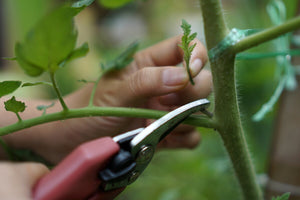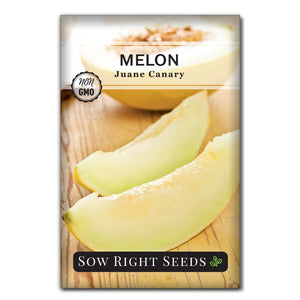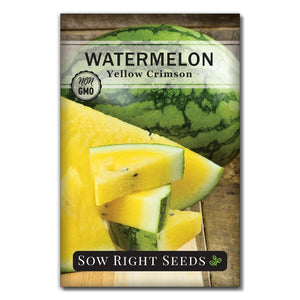How to Grow Heirloom Watermelon From Seed for a Sweet, Juicy Summer Harvest
MelonsJuicy, sweet watermelon will almost split itself. As soon as you cut into a ripe watermelon, you can tell by the sound of the splitting rind and the sweet aroma that you've just harvested the perfect watermelon.

The reward for growing your own heirloom watermelons is a flavor far beyond what you can find in a store. So, how do you grow the perfect, juicy, sweet watermelon?
Read on for our top watermelon-growing tips to have the picnic-perfect watermelon this summer.

How to Grow Sweeter Watermelon
To grow sweet, juicy watermelon, start by choosing a proven heirloom variety. The best watermelon seeds will give you the best watermelon harvest. Once you've chosen your seeds, the next 3 important parts of watermelon growing are preparing the soil, giving the right amount of water, and having enough heat.
Soil
Watermelons can grow very large and need a lot of nutrients to support all that growth. To enjoy a successful harvest, you need to start with the most important element–the soil. Good soil equals sweet, juicy melons.
Before planting watermelon seeds, check your soil for nutrients and pH. When they are first growing, you can add extra nitrogen, but after they have long vines, watermelon plants will need phosphorus and potassium for setting and growing fruit. In addition, calcium will help prevent blossom rot.
The soil for growing watermelons should be loose with lots of compost and able to drain well. The optimal soil pH is 6 to 6.8.

Water
Watermelons are 92% water, so of course, watering is the other critical element of growing juicy watermelons. But giving water at the right time is what makes a melon sweet.
While they’re growing, watermelons will need a lot of water. However, too much water can dilute the flavor. So when it’s almost time to harvest, decrease the amount of water. The last week you can stop watering.
Heat
Heat is the other factor for a successful watermelon harvest. Melon growth may slow if the days and nights are cool. Summer days of 86º F is the ideal temperature for growing watermelons. And full sun is essential too. 8 to 10 hours of direct light will give the watermelon plants enough sunshine.

How to Grow Watermelon from Seed
Once you have a location with full sun and rich, loose soil, you’re ready to plant watermelon seeds.
Watermelon plants love warm sunny days, so wait until the soil and air are sufficiently warm before planting watermelon seeds outdoors. The ground should be at least 70º F, with the daytime temperatures consistently above 70º F. Black plastic can be used over the garden space to warm up the soil and keep weeds out.
For a headstart in cooler climates, you can start watermelon seeds indoors 2 to 4 weeks before transplanting them outdoors. But be careful when transplanting watermelon seedlings outside, as the tender roots can suffer from transplant shock.

To plant watermelon seeds outdoors, create mounds of soil 3 to 5 feet apart. Plant watermelon seeds 1 inch deep and sow 2 to 3 watermelon seeds per hill. The hills will provide good drainage and keep water away from the base of the plant. Diverting it to the roots instead.
Keep the soil moist, and the watermelon seeds will germinate in 5 to 9 days.
When to Plant Watermelon Seeds
Knowing when to plant watermelon seeds is important because some varieties take a long time to grow to maturity. Depending on the type, watermelons can take 70 to 120 days to reach their full size.
Make sure to plant watermelon seeds late enough in the spring that all danger of frost is passed. When growing watermelon in the summer, check the variety to ensure enough warm days for maturity before the first fall frost.

Keeping Watermelon Plants Healthy
Once your watermelon plants are growing, you can thin them down to the strongest 1 or 2 plants per hill.
Watermelon plants will produce male and female flowers. Therefore, they need bees to pollinate the female flowers. If you don’t have pollinators visiting your garden, you can use a paintbrush to take pollen from the male flowers and brush it onto the female flowers that have a small fruit behind them.
Watermelons are heavy feeders and will continue to need nutrients. If needed, you can add a fertilizer that is high in phosphorus and potassium.
While they are growing, melons will need as much as 2” of water per week. But stop watering just before they start to ripen, and this will result in a sweeter melon.
As the melons grow, check where the bottoms rest on the soil. It is natural for this part to change color, but you don’t want it to rot. You can place a layer of straw, cardboard, or wood underneath each melon to keep it from rotting.

Solutions for watermelon pests and diseases
Cucumber beetles and squash bugs are two pests you want to keep far away from your watermelon plants. You can use floating row covers to keep bugs off the vines. But remove the covers when you have both male and female flowers so pollinators can reach the flowers.
Companion planting can also deter pests. For example, nasturtiums and marigolds can help deter cucumber beetles.
You can also limit the spread of diseases by not planting watermelons in the same place where you had cucumbers, pumpkins, or squash.
Keeping weeds out also helps to keep out diseases and pests. Many gardeners prefer to use black plastic to cover the ground. This will keep out weeds and keep the soil warm.
Watermelons can rot if they are on soil that stays too wet. Keeping melons off the ground will keep them from staying too moist and rotting. Placing a layer of straw or wood mulch will provide more airflow for healthy melons.

Harvesting Ripe Watermelons
All summer, you’ll be looking forward to the day when you can pick your sweet watermelon. So knowing when a watermelon is ripe is a critical skill.
How to Know When Your Watermelon is Ripe
You don’t want to go through all that effort to cut open a watermelon that isn’t quite ready. So how do you know when a watermelon is ripe?
If you have good ears, you can try the thump test. If you tap on it, a ripe watermelon will have a hollow sound. This method can take some practice and careful listening.
The thump test is fairly subjective. Fortunately, when you grow your own watermelon, you have better ways to know when your watermelon is ripe.

Checking the tendrils can be a more successful indicator of a ripe watermelon. When the tendril closest to the melon withers and turns brown, the melon is ripe. If the tendril is just starting to turn brown, you can use a marker to write the date on the melon. Then check it again in a week, and it should be ripe. This last week is also when you should stop watering.
Another indicator of a ripe melon is the coloring. A ripe melon will have a yellowish spot where it sits on the ground. This very pale green or pale yellow spot is called the field spot. Also, the overall color of the melon will be more on the dull side instead of shiny.

Fresh, sweet watermelon on a hot summer day is a beautiful thing. Unfortunately, watermelon doesn’t keep for long, so it’s best enjoyed soon after it’s picked. Once cut, it will only last about 4 or 5 days refrigerated in an airtight container. But with sweet, homegrown watermelon, its juiciness will soon be devoured.
If you dream of sweet, juicy watermelon for summer picnics, check out our heirloom watermelon varieties. This could be your year of amazing homegrown watermelon!









Leave a comment